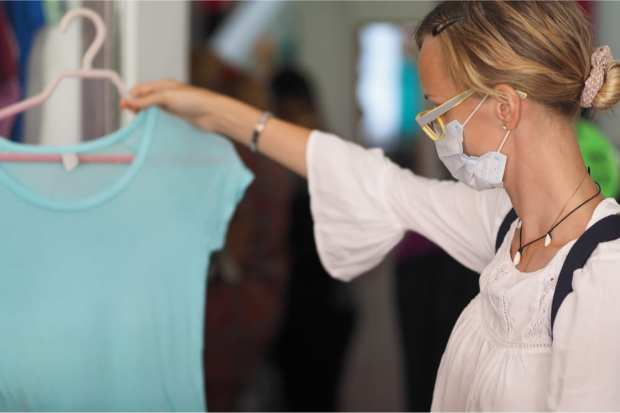Offline Shopping: Three Categories To Watch

The numbers are in. The latest in the PYMNTS COVID-19 series that quantifies the effects of the pandemic shows not only a deepening digital shift, but an increasingly sticky one. The research shows that 35.7 percent of consumers were shopping for retail goods online as of May 23, up from the 32.5 percent who were doing so as of April 27. This is a 29.4 percent increase of consumers who shopped online for retail goods on April 11 and 24.1 percent who did so on March 27. This means 73.1 million consumers are now shopping online, compared to the 66.4 million who were doing so in late March.
All of which raises a critical issue. Now that the digital script has been flipped, where are consumers shopping when they’re not looking for essential items like groceries, or when they’re not clicking away at home? We found three interesting areas: high-end fashion, deep discount apparel and dollar stores.
First, high-end fashion will take an overall revenue hit when the dust settles on 2020. But the ultra-high end is still being shopped at brick-and-mortar retail at countries that have gained some distance from the pandemic. For example, South Korea is seeing a luxury rebound in physical stores. And Chanel said on Wednesday (June 3) it was increasing prices on its handbags and leather goods by between 5 percent and 17 percent to protect its margins.
However, even the high end needs to be online. Vogue Business this week published a high-end fashion omnichannel index. It found that omnichannel is growing but still lagging behind the in-store experience. Ermenegildo Zegna received the highest score, scoring 63 out of 100 in online-offline integration and 80 in in-store experience.
Consumers are also shopping at deep discount apparel stores like Ross and TJ Maxx, even if they do so at a risk to their health. TJ Maxx has stopped reopening stores to customers on Saturdays because too many customers made proper social distancing impossible. “We have opted to not do Saturday openings because we’re getting so many customers and it was difficult for our associates to manage,” Ernie Herrman, chief executive of TJ Maxx parent TJX, said on an earnings call last week. He noted that there is a “pent-up demand” from shoppers. In Longview, Texas this week, more than 100 people lined up for the opening of Ross Dress for Less. “A Ross manager who declined to give his name said customers were encouraged to wear masks and follow social distancing inside and outside the store, which he said capped the number of customers inside at the same time at 126,” according to the Longview Daily News. “It is checking employees’ temperatures before they start work, and the store will also close an hour earlier than normal at 6 p.m., to allow for more cleaning.”
And consumers have also turned out at dollar stores. According to data from market research firm IRI, consumers are buying more private label brands, making more trips to dollar stores and fewer trips to convenience stores. Dollar Stores are also smaller and less crowded than big box stores. Analysts said the small footprint appealed to consumers seeking minimal contact during the height of the health crisis.
The offline shopping trends pale in comparison to the digital shift. At the very least retailers will need to prepare for a hybrid world, regardless of the next health condition it holds.
A question on everyone’s mind is, of course, “Will these changes last?” Even though the economy has slowly opened up, consumers are still reluctant to go out shopping, said Jun Li, associate professor of technology and operations at the University of Michigan’s Ross School of Business. “So for a while, retailers will have to continuously innovate how they do business. Online retailers will enjoy a premium for some time, as others struggle to attract people in stores. It is safe to say that any retailer lacking an online-offline strategy will find it difficult to survive the COVID pandemic and the era to come.”